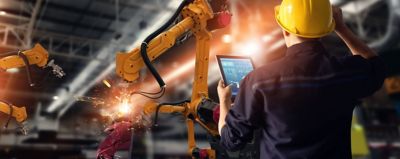With air-cooled compressors, the amount of recovered energy depends on workload - especially if it's a variable speed drive (VSD) rotary screw machine. Common solutions for this type include taking heat directly from the exhaust or using an air to heat exchanger. This heat is then used to keep the facility warm with a fan.
Simply put, energy recovery is a process where excess heat is reused within a facility's pipe or air duct network. Due to air compressor systems operating at such high temperatures, it's worth investing in equipment designed for recovering energy. This point is especially important since as much as 90% of electricity consumed by an air compressor is converted into heat.
When recovering energy, at least 75% of that power is turned into hot air or water. This is useful for radiators, laundries, canteens and kitchens, and ducting, among other functions. All this is done without compromising your air compressor's performance, while saving you on electricity expenses.
Since both energy costs and CO2 regulations are increasing, it's worth exploring how to recover energy from your air compressor system. Below you'll find more information on how this is achieved, and what options are available.
Energy recovery equipment
You can either invest in an air compressor with built-in energy recovery or an external EnergyBox. In both cases, you'll benefit from optimal conditions for utilizing waste heat. Built-in recovery claims 75% of thermal energy can be reused, while the EnergyBox states that it's possible to repurpose 80-90% of that heat. This is all due to an air to heat exchanger.
Like, with most efficiency equipment, the initial investment cost is offset by total savings throughout its lifespan. In most cases, the return on investment for energy recovery is 1-3 years. There are many factors contributing to this estimate, including facility size, and age of equipment. It's worth considering that a large operation consuming over 500 kW at more than 8,000 hours per year consumes 4 million kW annually.
When adding that up to 80% of an air compressor's total operational costs is electricity expenses, energy recovery is a valuable tool. It allows you to essentially become your own power plant for nearly anything involving heat.
How it works: air-cooled vs. water-cooled
As air compressors come with air-cooled and water-cooled methods, there's different ways heat is recovered from either option.
Water-cooled compressors offer more options, including providing heat for radiators. This capability is possible for air compressors with a temperature up to 90° C. If this hot water is to be used for showering, a base load hot water boiler is still needed. Regarding boilers, the waste heat generated from water-cooled compressors can periodically help a boiler run less.
The situation also changes if the air compressor is oil-injected or oil-free. Since oil is used to cool equipment, this limits high cooling water temperatures - making them more complex for recovering energy. Basic equipment usually consists of fluid pumps, heat exchangers, and regulation valves. Heat can also be distributed to external buildings with 40-80 mm pipes. Additionally, a heat exchanger can be used for air-cooled oil-lubricated rotary screw compressors to generate water heat recovery at 50°-60° C.
The optimal machine for recovering energy
Throughout this article, the potential for recovering energy is illustrated and how it applies to air compressor equipment. The optimal choice for maximum energy efficiency is a variable speed drive (VSD) rotary screw compressor with frequency inverter regulation (IVR) and built-in recovery.
These machines reduce energy consumption by up to 35%, compared to fixed speed equipment, and come with the latest technology. As we're always innovating, it's recommended to evaluate your air compressor system every 8-10 years.
While investing in new equipment is costly, it's usually worth it in the long run, especially regarding energy savings as mentioned in this article. If you still need help determining the best solution, feel free to reach out. Our team is happy to help point you in the right direction.
Looking for the right product for your application?
Get tailored advice
Still have questions after reading? Our expert is ready to help you make sense of it all and guide you to the best solution.
Write to an Expert Today – Get the answers you need.





